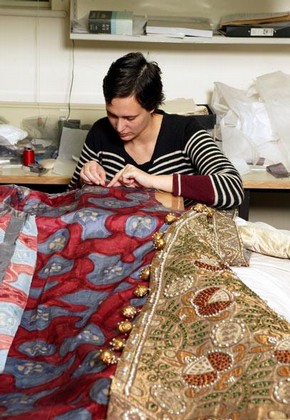http://www.vam.ac.uk/content/articles/d/decoration-in-stage-costume/
Play Mas
In Trinidad, play mas means carnival. Playwright Mustapha Matura took the phrase as the title of his play produced at the Royal Court Theatre in 1974, when the designer was Peter Minshall, himself born in Trinidad.
The glittering lurex and metallic fabrics of this spectacular cloak capture the riotous extravagance of present carnival while linking back to the African tribal past of the Trinidadian people. Its decoration incorporates symbolic images like the dove of peace, alongside a plethora of 'found' objects including coins, buttons, bottle tops, even budgerigar mirrors and bells, which glitter and move alongside the black and gold fringe and hanging bobbles.
Carnival costumes would naturally use such found items, but other costumes around the same period show similar influences, notably Timothy Goodchild's design for Ian McKellen as Richard II from 1968, a heavy ceremonial tabard, glittering with gold fabrics, paint, thread and metallic milk-bottle tops.
Another great influence on costume design of the period, were John Bloomfield's widely toured costumes for the 1970 award-winning television series 'The Six Wives of Henry VIII,' which borrowed many theatre techniques, using cheap materials and working them with paints, resins (see The Revenger's Tragedy) and screen-printing before drawing on them (see Le Coq d'Or) and decorating them with bottle tops. On screen they looked both rich and authentic.
Decoration in Stage Costume
Decoration on a costume can range from the extravagantly expensive, like Chaliapin's costume for the Coronation scene of Boris Godunov, to ingenious ways of suggesting opulence with inexpensive materials or the unexpected use of, say, industrial substances. Oliver Messel famously used coloured sweet papers, raffia, pipe cleaners and chandelier crystals, while Lila de Nobili mixed antique braids from period dresses with contemporary cheaper trims. Others saw the potential of DIY or technological introductions, as maker Ralph Dyer recalled about Desmond Heeley and the glue gun in the 1970s:
'He used to dribble it out onto a piece of lace, trace around and embellish the lace pattern and then leave it. It came out cream or honey gold. And all those puffings on the costumes … instead of being one long strip and all caught by hand, we made an individual one and then glue gunned it on.'
Nicolas Georgiadis used materials of different types and qualities appliquéd to the base fabric to create rich and sumptuous surface texture. His sumptuous costumes for Les Troyens and Aida at Covent Garden exploited this technique to the full. Philip Prowse, too, created richly extravagant costumes, building up layers of fabrics and braids.
Dyeing and painting costumes is a particularly creative field covering creating or painting fabrics and 'breaking down' costumes - this means distressing the fabrics to make them look faded, worn, damaged, etc. A design will indicate colour, texture and pattern, but textile dyers and painters need highly developed imaginations to decide how to achieve the effects - interpreting rather than translating the design, especially when building up complex surface textures.
To achieve a specific effect, textiles can be dyed, screen printerd stencilled, block printed or free-hand painted; bleach can take out colour. A cheap fabric can be made to look like brocade or leather, and silver-painted knitted string made to look like chain mail.
Once completed, costumes may be broken down or distressed to give the impression of age and wear by tearing, burning, painting or even using a cheese grater to simulate abrasions or dirt. A costume can even be made to look like a natural organic growth, rather than man-made.
For textile painter John Cowell,
'The more processes something goes through, the more interesting it becomes. We dye a velvet and print it with something that takes the colour out, then overdye it, paint into it and maybe overprint again and those textures become multilayered - it's like digging a hole in the earth, like stratas almost … We use screens, stencils, blocks, sponges - things that we pick up off the floor if they'll give the right effect.'


No comments:
Post a Comment